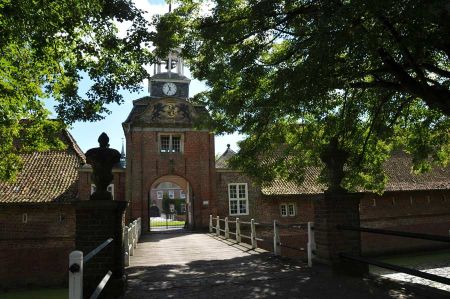Early romantic park at the moated castle of Lütetsburg
- Written by Portal Editor
Our preparatory planning for the coming year had once again taken us to northern Germany, this time the region around Norden and Norddeich was our destination.
The focus of our interest this time was the moated castle of Lütetsburg, its outer bailey and, above all, its unique landscape garden, which is open to the public as a park and is one of the few examples of early romantic gardens that have been preserved on the continent.
But let's start a little with the history of this moated castle complex, where a so-called Uthof (outer courtyard) of the Manninga chief family, the lords of Westeel, Pewsum and Bergum, had been built since 1212. Lütet I. Manninga probably had this outer courtyard converted into a stone house around the middle of the 14th century. He, Lütet, gave his name to the castle and the town of Lütetsburg that developed around it.
On October 9, 1373 there was a great flood
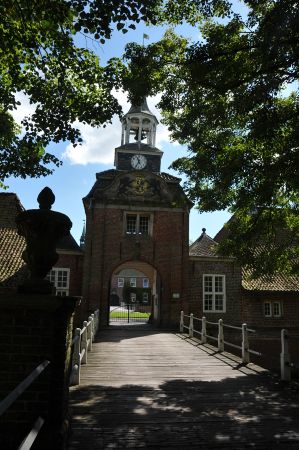 Since at that time there was still no closed dyke line along the coast to protect against flooding, his nephew Lütet II finally relocated the ancestral seat of the family to Lütetsburg, on the storm-proof Geestrand to the east of the city. This was preceded by the sinking of the old residence in Westeel in 1374 by the First Dionysius Flood. In 1374 and the following year, East Friesland was hit by devastating dyke breaches caused by flooding.
Since at that time there was still no closed dyke line along the coast to protect against flooding, his nephew Lütet II finally relocated the ancestral seat of the family to Lütetsburg, on the storm-proof Geestrand to the east of the city. This was preceded by the sinking of the old residence in Westeel in 1374 by the First Dionysius Flood. In 1374 and the following year, East Friesland was hit by devastating dyke breaches caused by flooding.
After the flood, the Leybucht reached its greatest extent at around 13,000 hectares, and the village of Westeel also had to be abandoned. As a result, the tide is said to have reached the city north, where the waves could penetrate to the walls of the Dominican monastery. From then on, the city had access to the North Sea and was given a port.
The water also penetrated deep inland via the bays of Sielmönken and Campen, which are now silted up. In the late 14th century, the parishes of Drewert and Walsum as well as the village of Ham were destroyed on the Rysumer Rücken. The historian Ubbo Emmius reports the effects in the 1590s:
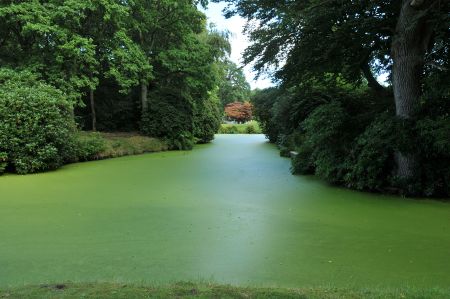 "On October 9, 1373, there was a great flood, the likes of which had not been seen in living memory, which extended over the entire Frisian coast and brought great misfortune to the inhabitants. For it covered the sizable village of Westeel, situated in a fertile country nearly 2,000 paces to the south from the north, and facing east toward the rising sun, with such a quantity of water that all the buildings, with the church, were pulled down and destroyed, nay, part of the ground was swallowed up and people and animals disappeared.” – Ubbo Emmius
"On October 9, 1373, there was a great flood, the likes of which had not been seen in living memory, which extended over the entire Frisian coast and brought great misfortune to the inhabitants. For it covered the sizable village of Westeel, situated in a fertile country nearly 2,000 paces to the south from the north, and facing east toward the rising sun, with such a quantity of water that all the buildings, with the church, were pulled down and destroyed, nay, part of the ground was swallowed up and people and animals disappeared.” – Ubbo Emmius
Due to the loss of the ancestral seat in Westeel, the grandson of Lütet II continued to expand the first stone house in Lütetsburg into a four-winged castle until 1430. The foundation walls of today's castle date back to this time. In 1514, during the Saxon Feud, troops of the Black Guard destroyed the castle in revenge for the East Frisian Count Edzard II having stolen three ammunition ships from them.
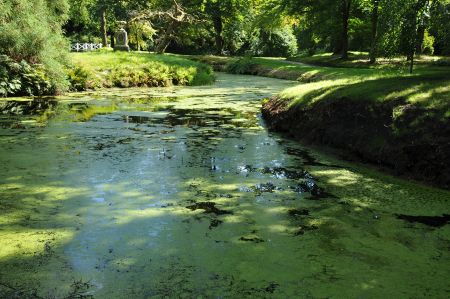 Chief Unico (Onneke) Manninga (1529-1588) had the castle surrounded by a moat rebuilt on its original site as a Renaissance-style castle between 1557 and 1576 and added a bailey to the complex, which survives to this day.
Chief Unico (Onneke) Manninga (1529-1588) had the castle surrounded by a moat rebuilt on its original site as a Renaissance-style castle between 1557 and 1576 and added a bailey to the complex, which survives to this day.
After Unico Manninga's death, his only daughter Hyma inherited the castle. By marrying the Reichsfreiherr Wilhelm zu Innhausen und Knyphausen in 1588, Lütetsburg came into the possession of the Knyphausen family (today the Counts zu Innhausen and Knyphausen), who are still the owners of Lütetsburg Castle with its park and forest.
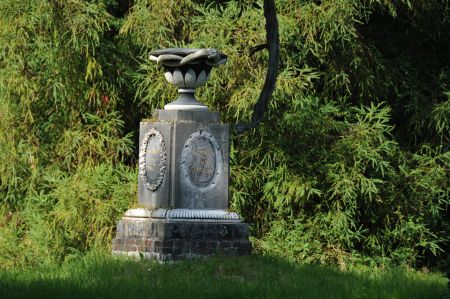 On Boxing Day 1893, a serious fire broke out in Lütetsburg. The trigger was a fallen Christmas tree. This ignited the canvas wallpaper. It took a very long time for the fire brigades from Hage and the north to arrive in Lütetsburg, so that they could no longer prevent the main castle, which was located within a wide gorge, from being almost completely burned down. Many artistically and historically valuable objects were also lost, such as hundreds of paintings by Dutch painters of the 17th century, an oil painting by the Prussian court painter Antoine Pesne, valuable Frisian and Dutch cupboards, tapestries and the entire armoury inventory.
On Boxing Day 1893, a serious fire broke out in Lütetsburg. The trigger was a fallen Christmas tree. This ignited the canvas wallpaper. It took a very long time for the fire brigades from Hage and the north to arrive in Lütetsburg, so that they could no longer prevent the main castle, which was located within a wide gorge, from being almost completely burned down. Many artistically and historically valuable objects were also lost, such as hundreds of paintings by Dutch painters of the 17th century, an oil painting by the Prussian court painter Antoine Pesne, valuable Frisian and Dutch cupboards, tapestries and the entire armoury inventory.
Count Edzard zu Innhausen und Knyphausen had the palace rebuilt in Neo-Renaissance style between 1894 and 1896 by the renowned Hanoverian architect Hermann Schaedtler. Schaedtler based his design on historical models from the Dutch-Danish Renaissance on the one hand, but also on more recent castle buildings in the family of the client on the other. A further expansion of the castle took place until 1908.
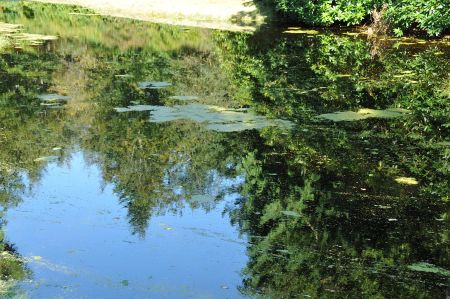 During World War II, in March 1944, 140 heavy bombs fell on the castle grounds. As a result, several people lost their lives and the castle suffered serious damage. It was then provisionally restored so that it was partially habitable. In 1956, for unknown reasons, it fell victim to another major fire. Prince Wilhelm Edzard zu Innhausen und Knyphausen then had the existing building rebuilt in a more modern style on the foundations of the earlier castles.
During World War II, in March 1944, 140 heavy bombs fell on the castle grounds. As a result, several people lost their lives and the castle suffered serious damage. It was then provisionally restored so that it was partially habitable. In 1956, for unknown reasons, it fell victim to another major fire. Prince Wilhelm Edzard zu Innhausen und Knyphausen then had the existing building rebuilt in a more modern style on the foundations of the earlier castles.
From the previous buildings, only the elongated brick building of the outer bailey and the gate tower have been preserved. The Inn- und Knyphausen family had the brick building of the outer bailey parallel to the street built in the 16th century in the style of the Dutch Renaissance. The two-storey gate tower with a round arch passageway, side pilasters, curved sandstone gables and lions holding coats of arms was built in 1731 in the centre of the outer bailey.
Castle Park Lütetsburg - First explanations by the court gardener
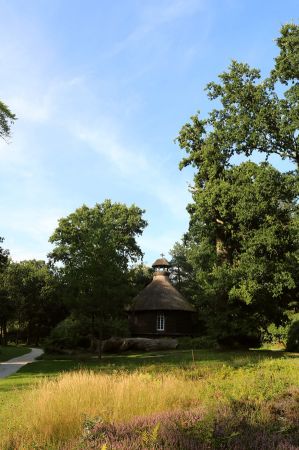 Once again, we were lucky. Coming from the large parking lot, you go straight to the outer bailey of Lütetsburg Castle, the entrance to the castle park is on the right, where a small tea cafe and information centre awaits visitors. In the information centre we saw an elderly man talking to the lady at reception. After our brief introduction, we quickly got involved in a conversation and learned that this was Mr. Folkert Fischer, the long-standing castle gardener and then the park guide.
Once again, we were lucky. Coming from the large parking lot, you go straight to the outer bailey of Lütetsburg Castle, the entrance to the castle park is on the right, where a small tea cafe and information centre awaits visitors. In the information centre we saw an elderly man talking to the lady at reception. After our brief introduction, we quickly got involved in a conversation and learned that this was Mr. Folkert Fischer, the long-standing castle gardener and then the park guide.
Even today, Folkert Fischer often thinks of the time when Wilhelm Edzard zu Inn- und Knyphausen (1908 - 1978) was his boss. "Do you have time?" the lord of the castle asked him on that last day in March 1954. And Fischer had hardly said yes when von Knyphausen said: "Then start tomorrow!"
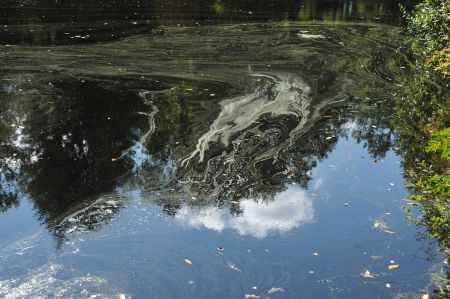 Folkert Fischer actually started the next day and stayed. For twenty years he worked in the greenhouses of the castle. "I lived with my family in the park administration building. Right next to the park.
Folkert Fischer actually started the next day and stayed. For twenty years he worked in the greenhouses of the castle. "I lived with my family in the park administration building. Right next to the park.
Those were good times." In 1973, Fischer then took over everything gardening from his predecessor Kaiser; Retirement followed in 1995, after 41 years. Guided tours of the park remained his profession, and hardly a day goes by when Fischer doesn't make sure things are all right. He always called his boss at the time "Prince" and addressed him as such; as did everyone in Lütetsburg and the surrounding area. The two men always spoke in Low German, which is how they understood each other best.
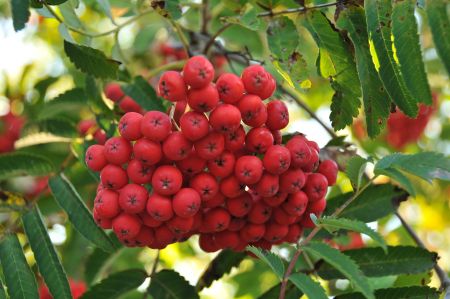 The Lütetsburg Castle Park was designed in the early 18th century in the Dutch Baroque style and, in line with the zeitgeist of the time, was divided into small sections. At the end of the 18th century, it had been devastated by conflicts of a military nature. Edzard Mauritz Freiherr von Inn- und Knyphausen then had it replanted by the Oldenburg court gardener Carl Ferdinand Bosse between 1790 and 1813. According to his plans, the largest private English landscape garden in northern Germany was created on an area of around 30 hectares.
The Lütetsburg Castle Park was designed in the early 18th century in the Dutch Baroque style and, in line with the zeitgeist of the time, was divided into small sections. At the end of the 18th century, it had been devastated by conflicts of a military nature. Edzard Mauritz Freiherr von Inn- und Knyphausen then had it replanted by the Oldenburg court gardener Carl Ferdinand Bosse between 1790 and 1813. According to his plans, the largest private English landscape garden in northern Germany was created on an area of around 30 hectares.
The turn to Romanticism in the spirit of Jean-Jacques Rousseau, which began in the second half of the 18th century, can be clearly seen in the complex. It is one of the few surviving examples of this early romantic garden type on the continent with 30 hectares of old trees, rare exotic plants, rhododendrons and azaleas.
 After all the stories and explanations by Folkert Fischer, we make our way into the park, following the indications to special points with ancient trees in the shade of which there are park benches that are at least as old.
After all the stories and explanations by Folkert Fischer, we make our way into the park, following the indications to special points with ancient trees in the shade of which there are park benches that are at least as old.
From ponds and watercourses, which are sometimes completely covered in green with duck curd, we reach a lookout hill, a wooden church based on the Norwegian model, find a great variety of tree species and plants. In short, it is a wonderful park landscape that invites you to go for a long day of walking, not just because of the idyllic paths. We spend hours in the park just to watch the play of light and shadow in the water of the ponds.
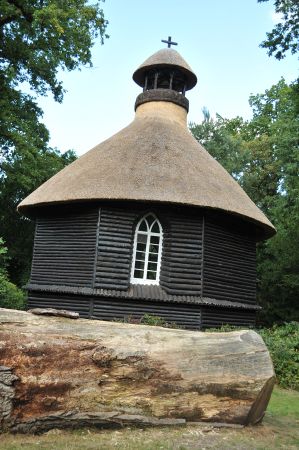 "An ancient castle on the seashore; a magnificent park in the treeless country...."- Theodor Fontane was inspired to write these poetic lines in 1882 while walking through the castle park. Of course, the time when the rhododendrons are in bloom is particularly attractive. Even autumn, with the onset of discoloration of the leaves, has its charms. A visit to the castle park of the moated castle Lütetsburg is therefore worthwhile in every season. At the end of our tour, we lingered for a moment in the castle cafe with an East Frisian tea with a hearty Kluntje and a dash of cream.
"An ancient castle on the seashore; a magnificent park in the treeless country...."- Theodor Fontane was inspired to write these poetic lines in 1882 while walking through the castle park. Of course, the time when the rhododendrons are in bloom is particularly attractive. Even autumn, with the onset of discoloration of the leaves, has its charms. A visit to the castle park of the moated castle Lütetsburg is therefore worthwhile in every season. At the end of our tour, we lingered for a moment in the castle cafe with an East Frisian tea with a hearty Kluntje and a dash of cream.
Please read as well:
Land yachting on sandy expanses of IJmuden Beach
Sremska Mitrovica from the perspective of an architect
https://www.alaturka.info/en/germany/lower-saxony/6265-early-romantic-park-at-the-moated-castle-of-luetetsburg#sigProIdeaf5224146
